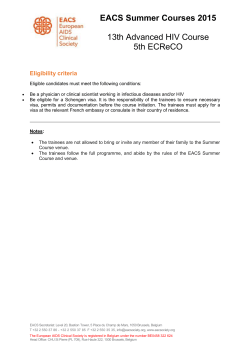
A Comparative study of Awareness towards Right to
Shilpa P. Patel [Subject: Education] International Journal of Research in Humanities & Social Sciences Vol. 3, Issue: 2, February: 2015 ISSN:(P) 2347-5404 ISSN:(O)2320 771X A Comparative study of Awareness towards Right to Education Act among B.Ed. trainees of Gandhinagar SHILPA P. PATEL Assistant Professor, Chaudhari Mahila B.Ed. College, Gandhinagar Abstract: In the present study researcher tried to find out the level of awareness among B.Ed. Trainees, who are future’s teachers of Gandhinagar city. Via this study the researcher wants to convey that if we much aware about RTE, then we lead ourselves and our society for their fruitful development and sustainable performances in the field of education. Keywords: Awareness, RTE act, Education, Trainees of B.Ed. 1. Introduction The Right of children to free and compulsory Education act, 2009 which is known as RTE Act, 2009 has been inserted by the 86 th amendment in December, 2002 and passed by the parliament in July, 2009 and it was implemented on 1st April, 2010. The success of any policy or legislation or act lies in its implementation. India is rated at 108 per literacy rate of the countries at the global level in 2010 and there should be some concrete efforts to imply the policy or act. It includes creating awareness among teachers is required to make the RTE act reality. This problem arose in researcher’s mind that the government spend huge amount for implementation of this act and if our teachers are not well informed on the basic provisions of this act, it will remain a piece of paper. 2. Objectives of the Study The objectives of the present study are as follows 1. To find the differences in RTE awareness among male and female B.Ed. trainees of Gandhinagar. 2. To Compare the RTE awareness among the B.Ed. Trainees belonging to rural and urban areas. 3. To Compare the RTE awareness among the B.Ed. Trainees belonging to Science and General Streams. 3. Hypotheses In the light of the objectives, the following hypotheses were formulated. Ho1: There is no significant difference in RTE awareness among male and female B.Ed. trainees. Ho2: There is no significant difference in RTE awareness among rural area and urban area’s B.Ed. trainees. Ho3: There is no significant difference in RTE awareness among Science stream and general stream’s B.Ed. trainees. 4. Methodology In the present study descriptive survey method was employed. It was designed to explore the RTE awareness among B.Ed. trainees. 4.1 Sample The questionnaire was used on 138 B.Ed. trainees of Gandhinagar were selected by random sampling method. Detail of sample is given in following table. 29 Online & Print International, Refereed (Reviewed) & Indexed Monthly Journal www.raijmr.com RET Academy for International Journals of Multidisciplinary Research (RAIJMR) Shilpa P. Patel [Subject: Education] International Journal of Research in Humanities & Social Sciences Vol. 3, Issue: 2, February: 2015 ISSN:(P) 2347-5404 ISSN:(O)2320 771X Table 1. Sample of the study Science Stream General stream Male Female Male Female Rural Urban Rural Urban Rural Urban Rural Urban 15 19 15 20 15 19 15 20 34 35 34 35 69 69 Total = 138 4.2 Tool The tool for this study was a self made questionnaire. It contained 20 multiple choice items related to RTE awareness. The test was administered and the responses made by B.Ed. Trainees to test the RTE awareness were scored, tabulated and analyzed using appropriate statistical techniques. 4.3 Analysis, Result and Discussion Ho1: There is no significant difference in RTE awareness among male and female B.Ed. trainees. Table 2. Statistics of the trainees of Male & Female Group N Mean S.D. Male Female 68 70 10.34 9.55 2.93 2.41 Mean ‘t ‘ ratio differences 0.79 1.88 There are no significant differences in RTE awareness among Male and Female B.Ed trainees. Observation of table-1 reveals that the t-ratio is 1.88 which is not significant at 0.05 level. It means that male and female B.Ed. trainees have equal awareness. Hence, Null hypothesis is accepted. It is therefore, concluded that there is no significant differences in RTE awareness among male and Female B.Ed. trainees. Ho2: There is no significant difference in RTE awareness among rural area and urban area’s B.Ed. trainees. Table 3. Statistics of the trainees of rural & urban area Group N Mean S.D. Mean differences ‘t ‘ ratio 0.49 1.16 Urban 78 10.19 2.59 Rural 60 9.70 2.83 There are no significant differences in RTE awareness among rural and urban area’s B.Ed trainees. Observation of table-1 reveals that the t-ratio is 1.16 which is not significant at 0.05 level. It means that rural and urban area’s B.Ed. trainees have equal awareness. Hence, Null hypothesis is accepted. It is therefore, concluded that there is no significant differences in RTE awareness among rural and urban area’s B.Ed. trainees. Ho3: There is no significant difference in RTE awareness among Science stream and general stream’s B.Ed. trainees. Table 4. Statistics of the trainees of Science & General stream Group N Mean S.D. Mean differences ‘t ‘ ratio 1.96 4.9 Science stream 69 10.92 2.99 General stream 69 8.96 1.99 30 Online & Print International, Refereed (Reviewed) & Indexed Monthly Journal www.raijmr.com RET Academy for International Journals of Multidisciplinary Research (RAIJMR) Shilpa P. Patel [Subject: Education] International Journal of Research in Humanities & Social Sciences Vol. 3, Issue: 2, February: 2015 ISSN:(P) 2347-5404 ISSN:(O)2320 771X There are no significant differences in RTE awareness among science and general stream’s B. Ed. trainees. Observation of table-3 reveals that the t-ratio is 4.9 which is significant at 0.01 level. It means that science and general stream’s B.Ed. trainees have unequal awareness. Hence, Null hypothesis is rejected. It is therefore, concluded that there is a significant differences in RTE awareness among Science stream and general streams B.Ed. trainees. 5. Conclusion and suggestions It is true that there is no significant difference on awareness among male and female B.Ed. trainees of rural and urban area. But the average score of this group have makeable differences. General streams B.Ed. trainees are not well aware about RTE Act-2009. The B.Ed. colleges should organise seminars and workshops on RTE Act-2009. They should give this point as a part of syllabus. Government should make it compulsory to learn RTE Act in B.Ed. / M.Ed. colleges. The government needs to plan and organise one week / three days short term course with sufficient study material. Such initiatives are necessary to to create awareness among all B.Ed. and M.Ed. colleges, who will give their best to achieve the goals of RTE to make it attainable and successful. References 1. Devesher, M. (2005). E-governance as a tool to implement Right to Education, The Government Conference, New Delhi, October-17/9/2005. 2. Saroj and Kanchan (2010). “Right to education in India as a fundamental right”, National seminar on 21st January. 3. The gazette of India, August, 2009. 31 Online & Print International, Refereed (Reviewed) & Indexed Monthly Journal www.raijmr.com RET Academy for International Journals of Multidisciplinary Research (RAIJMR)
© Copyright 2025









